Disclaimer: I am not a doctor nor a health professional. The following post comes from what I’ve researched and what I’ve discussed with my own doctor. As always, consult with your physician before taking any supplements. This is post is not intended as medical advice.
This DIY Magnesium Body Butter Recipe might be just what you need to add to your regime at home. It’s simple to make, too!
It seems that every time I google about my migraines or why I crave chocolates I always end up reading about magnesium deficiency. The more I read about it, the more I realized I am suffering from magnesium deficiency and probably you are too.
Magnesium deficiency can cause muscle cramps, restless legs, migraines and headaches, irritability, fatigue, hypertension, and sleep problems. It has also been linked to digestion and heart health, fertility, strong bones and many more things. Magnesium regulates over 300 biochemical reactions in our bodies! Basically, our body needs magnesium for proper functioning however it is believed that now a days most people suffer from magnesium deficiency.
If you want to know more about magnesium I recommend you read this post or get The Magnesium Miracle by Dr. Carolyn Dean. She goes into great detail about magnesium, why it’s important and how you can achieve optional health by having adequate levels of magnesium, amongst other things.
The tricky thing with magnesium is that it is best absorbed via eating vegetables and through your skin. The problem with depending on vegetables to get enough magnesium is that our soils are depleted of this mineral, therefore our vegetables don’t contain the same levels of magnesium they used to and that’s why many of us don’t have adequate magnesium levels.
You can also buy magnesium supplements, I drink this supplement this supplement and it has helped me, but the best way for your body to absorb magnesium is through your skin.
DIY Magnesium Body Butter Recipe
I used to spray this magnesium oil on my legs, leave it on for 20 minutes, and then take a shower to remove it because it left my skin feeling sticky. The problem with this is that it was very itchy. Some people told me it was because of my lack of magnesium and that if I kept using it the itchiness would go away. I eventually stopped using it all together because it was too itchy.
However, my naturopath confirmed I needed more magnesium and I decided to try the magnesium oil again, this time in body butter form. This was the perfect solution, I was getting the magnesium, without the itchiness plus it hydrated my skin. It was a win-win.
I’ve found that using about 1 teaspoon of this cream per day is what my body needs, but everyone is different. Start by using a small amount and work your way up until your magnesium deficiency symptoms are gone. Remember that once the big signs of magnesium deficiency are gone, you still have to make sure you’re getting enough magnesium.
My recommendation is to incorporate this body butter as part of your health regiment. You can apply it a few times a week and even once a day. I started using it every day and now I only use it a couple of times per week.
If you’re putting any form of magnesium on your body you want to make sure you skin has enough time to absorb it. Make sure when you use this magnesium body butter you leave it on your skin for at least 20 minutes. I personally just put it on at night and go to sleep with it.
What are some ways to use this magnesium lotion?
- If you’re feeling muscle cramps, you can rub this lotion in that area.
- If you’re experiencing morning sickness and pregnancy heartburn, use this lotion daily.
- If you’re getting a tension headache, rub it on the back of your neck.
- If you need to relax at the end of a busy day, rub it on your body. Even better, have your partner massage your back using this body butter.
- Studies have shown that adding magnesium decreases some symptoms of ADHD in kids, helps them relax and sleep better. This lotion is safe to use on kids and I recommend putting it on their feet.
Magnesium is a supplement we all need and this body butter is the perfect way to get this supplement. Even if you don’t show deficiencies of magnesium it would be a good idea to add this lotion to your weekly routine. Plus it is so easy to make!
What is the best way to store this magnesium lotion?
I keep mine in the fridge but that is just because I like how it feels on my skin when it’s nice and cool. It’s really nice as well if I’m using it for sore muscles after a workout or a run.
How do you use magnesium body butter?
It all depends on what you want to use it for. As I mentioned above, you can use it as part of your heath regime that can really help with overall pain. I use it a few times per week and have really noticed a difference.
Did you know we have an e-book with 40 DIY recipes for bath and body products
⇒ ⇒ Check it out ⇐ ⇐
DIY Magnesium Body Butter
This recipe makes enough lotion to fill four of these 4 oz. glass jars. I usually make one batch and give 2 of the jars to my family or friends, but if no one needs magnesium body butter I cut the recipe in half. Keep in mind that this lotion last a long time since you only need 1/2 – 1 teaspoon at a time.
One teaspoon of this body butter contains around 250mg of magnesium.
Ingredients:
- 8 tablespoons of shea butter
- 3 tablespoons of coconut oil
- 2 tablespoons of grapeseed oil (if you don’t have any, you can just add 4 tablespoons of coconut oil instead)
- 1/4 cup of Ancient Minerals magnesium oil
Directions to make this DIY Magnesium Body Butter Recipe:
Using the double boiler method, melt the shea butter and coconut oil. Once the ingredients have melted, put them in a glass bowl and leave it on your counter.
When the mixture has cooled down add the grapeseed oil and magnesium oil and mix it well. Place the bowl in the fridge until the lotion hardens, about 30-60 minutes. I usually make this lotion at night and then continue with the remaining steps the next day.
Once the magnesium body butter has hardened, use a hand mixer to whip up the lotion.
Whip it for a few minutes until you don’t see any big chunks of lotion left.
Then transfer the body butter to an airtight glass jar to store it.
Start by using 1/2 teaspoon a day and work you way up to 1 teaspoon a day. Most people prefer to put in on their feet, legs, arms and/or back. A little tingling sensation is normal, however this lotion shouldn’t hurt nor give you a rash. I’ve never seen this happened but if it were to happen to know, you’re probably allergic to one of the ingredients.
You can keep a small jar of magnesium body butter in your bathroom and store the rest in the refrigerator. This way you won’t have to add any preservatives. During the summer months I love keeping the lotion in the fridge because it feels so good on your skin to apply a cold body butter.
Now you can supplement with magnesium in a way that your body can absorb it. As with any supplement, you won’t notice the changes overnight but you will in a few weeks, if you’re consistent with it.
I personally have noticed an improvement in my migraines and this lotion helped me get through pregnancy. My husband loves it for when he has sore muscles and I use it on my kids’ feet on some nights because I don’t want them to become deficient. The best part is that by using this lotion on a regular basis you will notice a big improvement in your and your family’s overall health.
This is one of those body butters that it’s a must-have in every household!
Have you made your own magnesium body butter?
DIY Magnesium Body Butter Creation
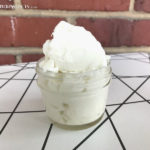
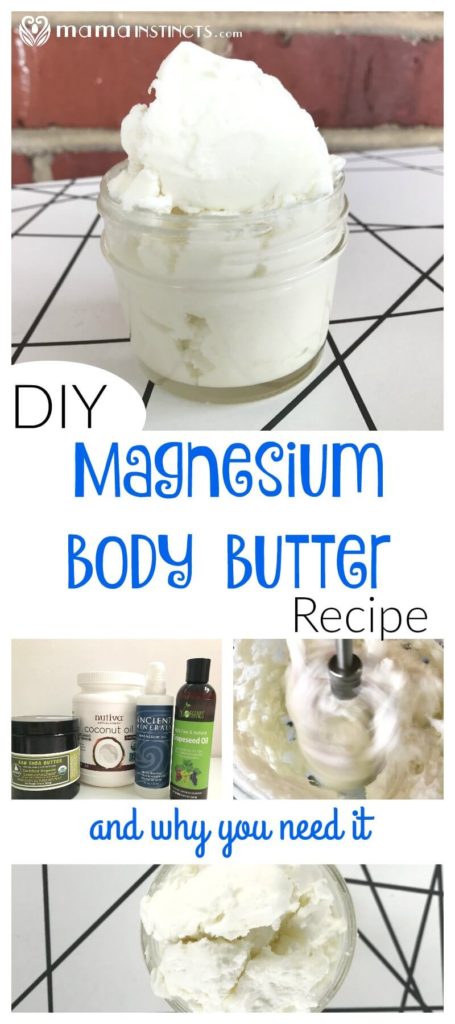

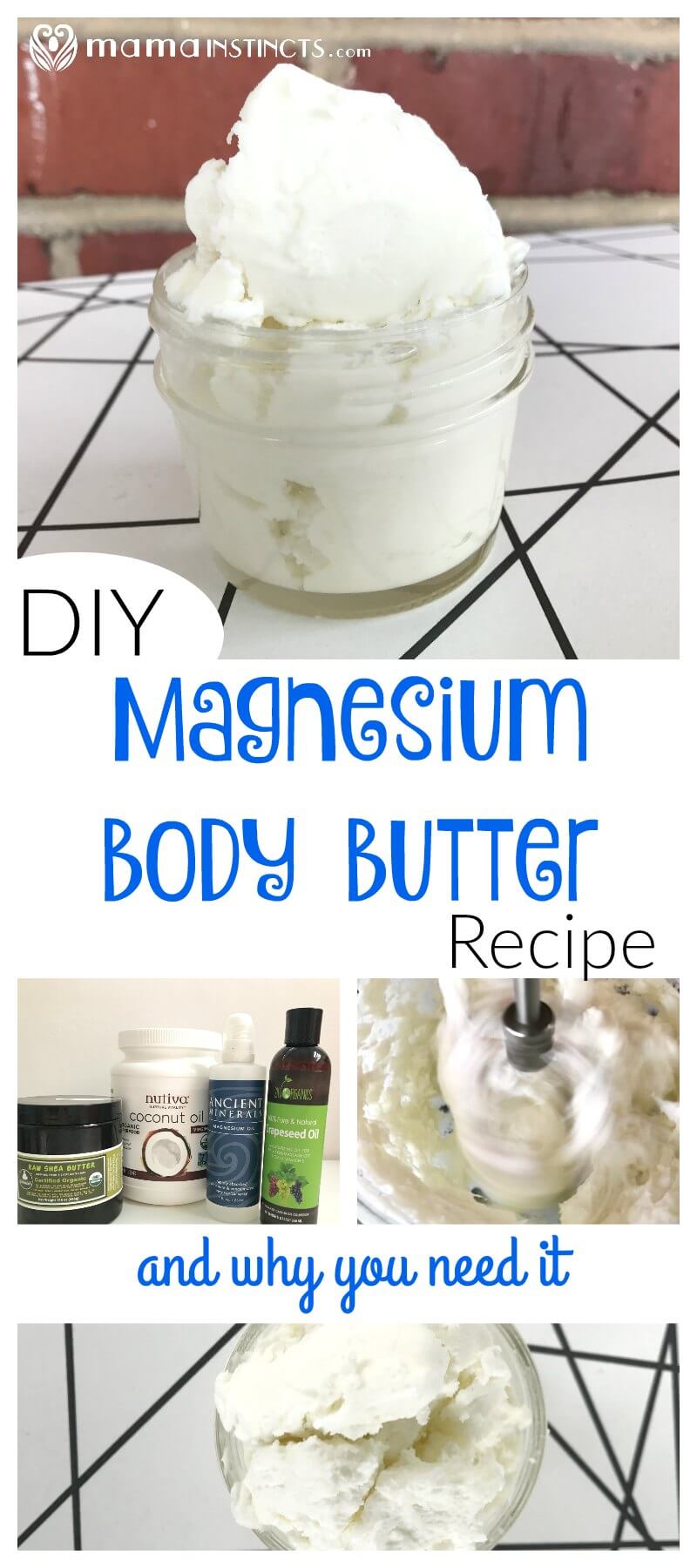
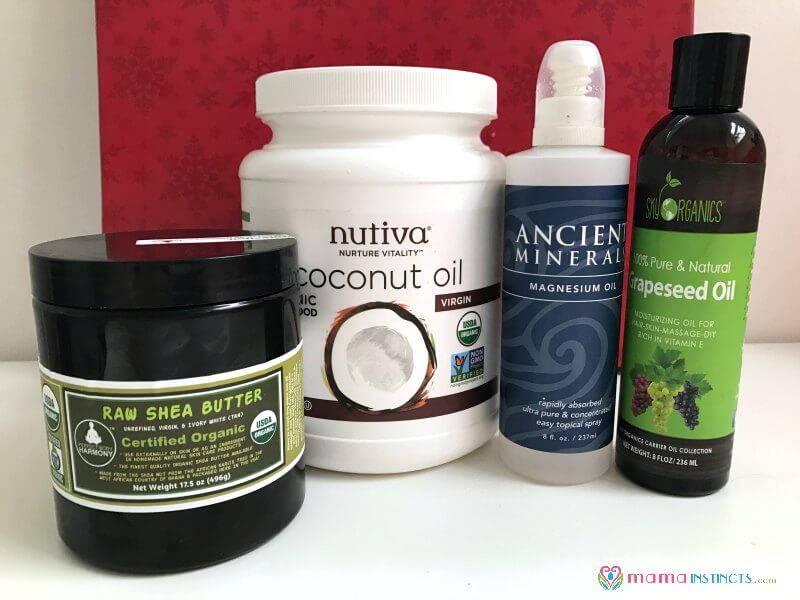
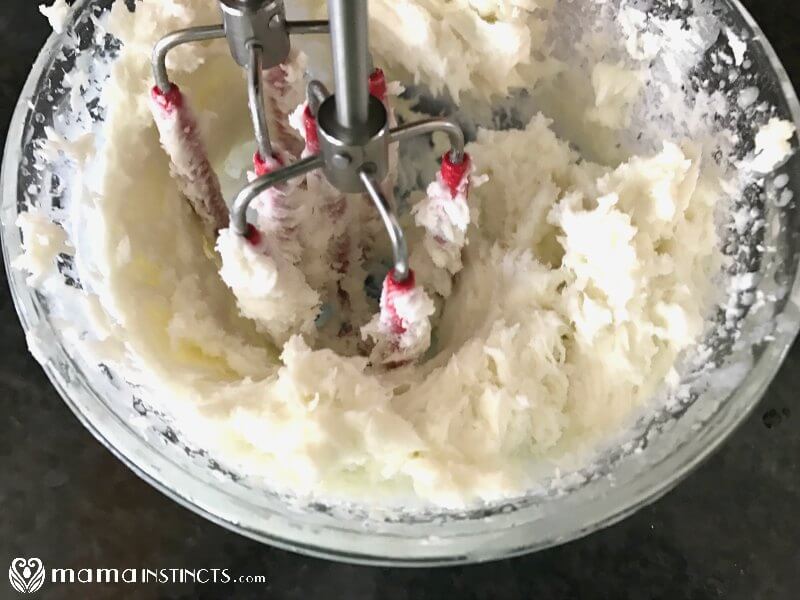
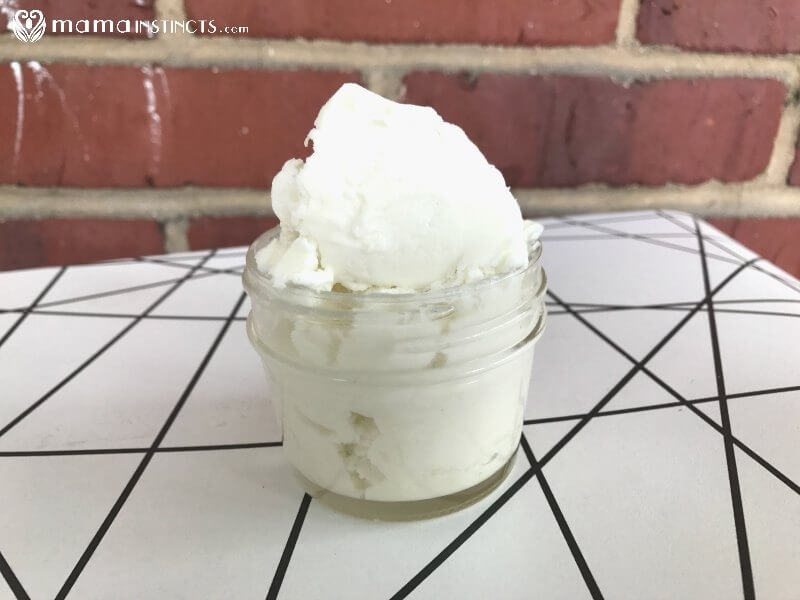
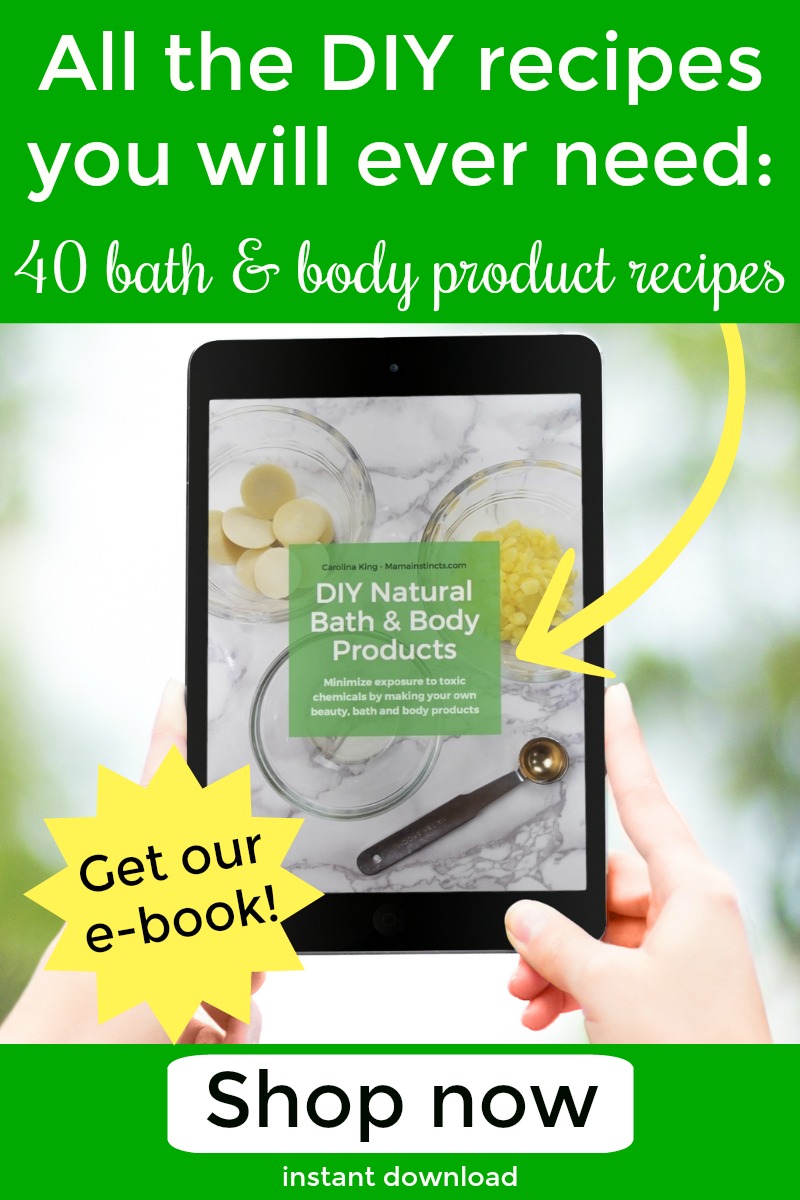
I have never heard of magnesium being applied this way but it’s Genius! Thank you for sharing! What would you suggest for substituting Shea in the recipe? I have a reaction too it and so do my little ones. Appreciate any suggestions!
Hi! You can use cocoa butter, like this one: http://amzn.to/2o4M8aS (affiliate). If that doesn’t work you can try with mango butter too. I’ve made it with both shea and cocoa butter and it comes out great!
Tried it with Cocoa butter and it went back to being hard like a rock. Does not work and mix after that.
Do you recommend using this product on your belly? I wanted to also make a stretch mark body butter, and thought “two birds with one stone!” Unless you see that as being a problem.
Yes! That’s not a problem. I use it on my entire body.
Could I add a fragrance to this recipe?
What can I use instead of coconut oil, I’m allergic
Can I add essential oils to this body butter? If so, when would I add it?
restless leg syndrome RLS is not a magnesium defficance. Magnesium does noting for restless legs.
Actually, studies have shown that magnesium can help with symptoms of restless leg syndrome
It has helped my restless leg syndrome.
this isn’t true, magnesium absolutely helps RLS. I have suffered for years and my flair ups are always a result of low magnesium.
This looks so good! What a great gift to make for friends or to enjoy yourself!
Thanks for sharing! Does it freeze well?
I haven’t tried freezing it before, but i don’t see why it wouldn’t work!
Guten Tag, kann man der Magnesium Bodybutter ein ätherisches Öl zufügen?
I just made this and added about 15 drops of lavender essential oil. I love it and cannot wait to gift it to my sister and my friend. 💜
I can’t wait to make this! Magnesium tablets are huge! I hate taking them. And taking it through the skin (like directly on my calves) sounds awesome! Thanks so much!
How long will it store in the fridge or at room temp?
When you said replace grape seed oil with 4tbsp coconut oil is that in addition to the coconut oil previously mentioned or a total value?
Thank you
can I add essential oils to this?
Yes!
Can you use another high quality brine if you don’t have Ancient mineral brand? I made a similar recipe and there was water that kept collecting in the jar.
Yes, you can use another one but I’ve only done it with the ingredients listed here so the texture could come up different.
I’m having trouble getting the magnesium to mix with the shea and coconut – any suggestions? Thanks!